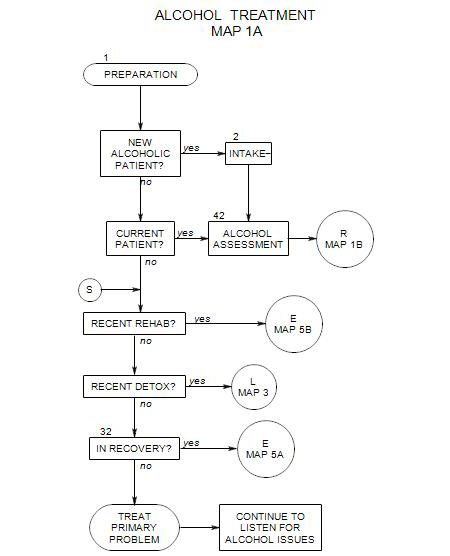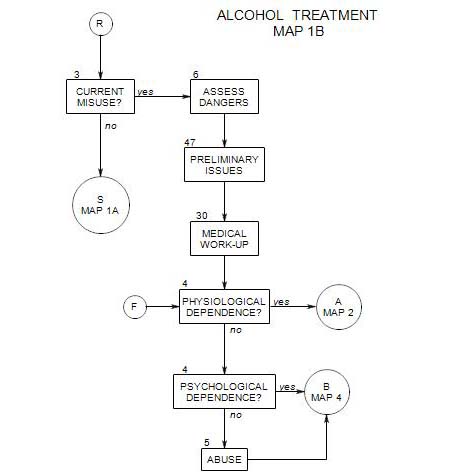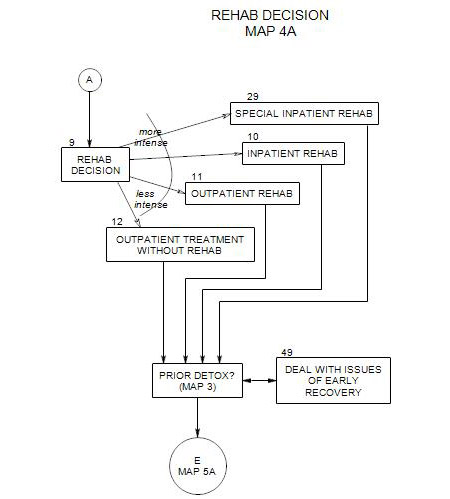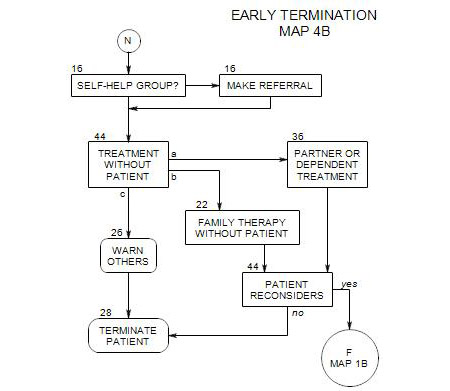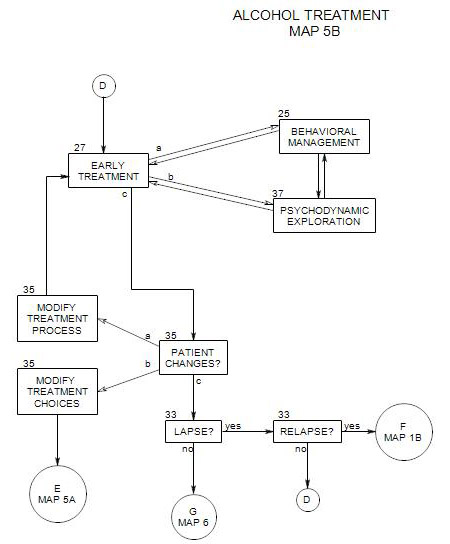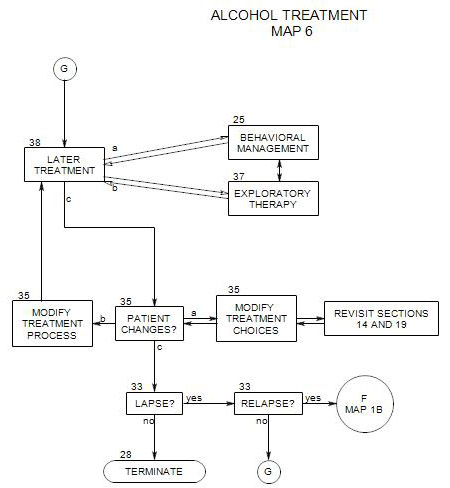22. FAMILY THERAPY
- This section follows either Section 14 [Primary Care Decision] Section 19 [Adjunctive Care Decision] or Section 44 [Treatment Without the Patient]. Family therapy is related to Couple Therapy [ Section 17 ]. See also Section 21 [Involving Significant Others] and Section 36 [Treating Partner or Dependent]
The members of a family are constantly interacting with each other over an extended period of time. They develop patterns of reacting that promote stability and safety, establish roles and relationships, and often perpetuate the addiction of the alcoholic member or members [Howard and Howard, 1985, 191-192].
Family therapy takes into account the established relationships within a family and works with them. Other family members are included directly in the treatment. The patient becomes the identified patient, and other members of the family may be seen as allies in his/her therapy or as additional patients. Alternatively, the family is taken as the patient or unit of concern, and the identified patient as a focal point within the larger context. In some cases, the context of concern can include the extended family, friendships, or even the neighborhood. In either case, the perspective on the identified patient and his/her issues differs from the one in individual treatment.
Family therapy focuses the treatment on the family as a functioning entity. If the greatest leverage can come from treating individual family members, see Section 36. For a discussion of the advantages and uses of family therapy, see Section 14.
There are many variations on family treatment [Dulfano, 1985, p.137]. You can include all family members in the same sessions or break them into subgroups as indicated by the psychological issues, interactions, and the power distribution in the family. You can work with some family members and not others. Some can be treated individually, others only in group settings. Some, including the identified patient, may be seen both individually and with other family members.
Typically, younger children are not included when the identified patient is an adult, for a variety of reasons, including disruptions in the intergenerational power relationships and risk of exposing them to issues that they are not prepared to understand. They may be involved when the identified patient is an adolescent or the family task is to hold an intervention [ Section 13 ] that convinces an alcoholic family member to go to detox.
The start-up issues for family treatment include:
- which family members should and will participate in treatment. Of those, which will be involved in family sessions, and why.
- whether the identified patient will participate in family sessions or not.
- what to do about family members who refuse to participate.
- what the goals of family sessions will be.
- whether the focus on the family is to be primary, with indirect benefits to the identified patient, or whether the family treatment is to be adjunctive to work that is focused on the identified patient.
- whether individuals should be seen separately, and if so, how much emphasis should be placed on individual versus group work.
Early in treatment, family sessions can help to assess the level of dysfunction of the total system of which the patient is a member. They can also help to get a handle on the extent of the identified patient’s problems and their relationship to the family structure and the issues of other family members.
Often, the pathology of the identified patient has a function within the family context, possibly as a real or imagined source of family problems and conflicts.
Some family members may be cooperative in working with the therapist and the identified patient to relieve pressures and institute reforms. Others may react to the patient’s sobriety and therapeutic gains in ways that serve to pressure him/her to return to drinking, including rejection, distrust, criticism, etc. They may try to make the patient ineffective in the family dynamic or retain the idea that the identified patient is the source of all family pathology and dysfunction. An early job is to identify which family members are likely to support treatment and which to impede it. Then treatment can be structured to provide the greatest benefits.
Ongoing family therapy, if others will participate, can relieve pressure on the patient to relapse, as well as helping to make family members more supportive of each other. It is also common, early in treatment, to refer the patient’s spouse to Al-Anon and adolescent children to Al-a-Teen.
Periodic sessions with the spouse or another family member can give a different perspective on how things are going; with the other person serving either as an informing participant in the treatment of the alcoholic, or as a co-dependent who needs his/her own help. These sessions also help maintain the involvement of the other person, whose support can be tested by changes in the patient.
22a. Types and Theories of Family Therapy
When a patient is involved in both individual and family treatment, there are opportunities for the two modalities either to support or to conflict with each other. It pays to assess the compatibility of the approach of the family therapist before making a referral, to assure that the patient will receive help consistent with individual treatment. At that time, the choice can be made as to whether treatment should start from an individual or family perspective, which modality should be considered primary and which secondary, and when and under what conditions the adjunctive form will be introduced.
A discussion of four major approaches to family therapy can be found in McKay [1996, 148-156] and McCrady and Epstein [1996, 118-123]. They include the following.
PSYCHODYNAMIC APPROACH
Here family members are helped to become more aware of automatic behavior, avoidances, unexpressed wishes and emotions, and the unconscious meanings of their reactions to one another. They are then encouraged to engage with one another in more direct and conscious ways. Family sessions tend to be informally organized in the service of openness and understanding of one another.
BEHAVIORAL APPROACH
Here the conscious actions of family members are emphasized, and more effective actions are encouraged. Group sessions are generally structured by the therapist around issues such as controlling drinking behaviors and/or improving interpersonal relating. A number of specific techniques may be used to change the habits and reactions of family members, including behavioral contracts and homework. The effectiveness of interventions may be assessed using rating scales and checklists, and interventions modified as needed to be more effective.
FAMILY SYSTEMS APPROACH,
Here, dysfunctional patterns of family interaction and relationship are explored and adjusted. Treatment may involve exercises in which family members are encouraged to react to one another in their usual ways, and when problems arise, more effective forms of relating are attempted. The behavior of the identified patient may be interpreted as serving a useful function for the family, thereby explaining some resistance of other family members to the patient’s attempts to stay sober. If that is happening, understanding it opens the door to better understanding of family needs and may lead to alternative solutions for achieving them. Analysis of family structure may reveal that ineffective or inappropriate subgroups have developed over time, and suggest that changes in the psychological boundaries within the family can bring the family system into better balance, and relieve the identified patient of some of the pressure to drink.
FAMILY DISEASE APPROACH.
Here, different family members are assumed to be dealing with different aspects of a shared disease process. However, the focus is on how each family member expresses the disease – through drinking, denial, enabling, codependency, or avoiding and detaching. The problem is to deal with the disease within each family member, and the assumption is that relationships within the family will improve as each of the members improves. Family sessions may be used at the outset of treatment, but the goal is for each person to move toward his/her own individual recovery, commonly through one of the 12-step programs.
22b. Common Issues for the Family
A number of issues tend to come up when working with families, including –
- trust, or lack of it, among family members.
- inappropriate boundaries and alliances among family members
- lack of respect by some family members for the individualities of others.
- difficulties in communication, especially of personal thoughts and feelings.
- assumptions about what others know or what their motives are.
- definitions of members’ roles and judgments about how they are enacted.
- setting limits to each others’ behavior and adhering to agreed-upon limits.
- isolation of the family from the outside world and hiding from it.
- enabling of the alcoholic by others.
22c. Family Therapy as Primary
Family therapy assumes that the most effective approach to dealing with the issues of the identified patient will include the entire family. This could happen if you think of the identified patient’s symptoms as largely expressive of some unaddressed family dynamic.
Family therapy can have the effect of redistributing power within the family and conferring some of the power on the therapist. The therapist can observe and redirect all members, control aspects of communication, suggest modifications in family assumptions, rules and habits, and alter alliances and the distribution of power.
Family sessions may begin as the most effective form of treatment and then become adjunctive to individual therapy as family issues become more manageable, the personal issues of family members become identified and salient, and some family members drop out or move on to their own individual treatment.
22d. Family Therapy as Adjunctive
Here the identified patient remains central to therapeutic effort, and individual therapy is the major form of treatment. Typically the identified patient is a participant in family sessions as well as in individual work. Even when others a re discussing their reactions to the identified patient and considering alternative ways for managing his/her behavior, the patient can often participate actively and effectively.
Treatment may focus on –
- increased awareness by others of the patient’s condition and its real and potential consequences.
- exploration of alternative behaviors toward the patient.
- other issues of family members that may not involve the patient.
Family members must learn to stop enabling the alcoholic behavior by –
- not cleaning up his/her mess.
- not covering for him/her (calling in sick for him/her when s/he is hung over).
- not giving him/her money out of sympathy, etc.
- not believing his/her lies and deceptions.
Early in treatment, the family of an alcoholic patient can operate as a team to help the patient maintain sobriety, along with individual therapy and 12-step participation. In this form of the work, commonly known as network therapy [Galanter, 1993], family and friends are part of the treatment process and not treated for their own issues.
If the identified alcoholic is unwilling to work with others in dealing with the problem, treatment may follow different paths. Section 44 considers some of these issues.
22e. Family as Behavior Therapists
It is not unusual for alcoholics to be uninterested in or opposed to treatment, and at the same time for others in the family of the identified patient to be concerned, frightened, angry, hurting, or otherwise in distress. In this case, the therapist can work with the patient’s family and friends, who are taught to encourage the patient to reduce the amount and frequency of drinking and eventually to begin his/her own therapy or drug treatment. The overall treatment strategy is to empower other family members and teach them more effective ways to encourage the identified patient to reduce or stop drinking [Miller, 2003, 145-147]. See Section 44 for more on this.
22f. Risks of Family Therapy
Families tend to become stable systems, even dysfunctional stable systems. By the time they get to treatment, family members have made adaptations to the way things are and may be fearful of any change, even change that is intended to improve their lives.
Resistance to change can occur with any form of treatment. However, family therapy attempts to involve all members as active participants in the change process. There is a risk that an attempt to re-structure the family will lead to many obstructive behaviors from the identified patient and other family members at the same time [Dulfano, 1985, 136].
